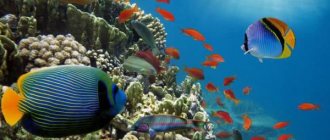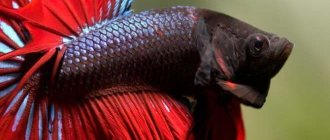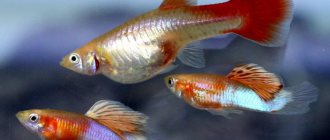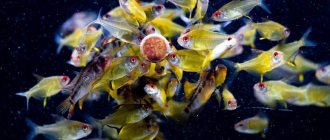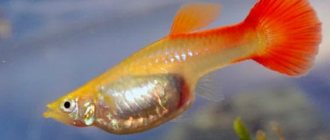02/12/2019Pisces0
Popular fish from the poeciliaceae family do not require complex care, have a beautiful, bright color, and therefore are favorites of aquarists. Those who want to breed guppies need to know all the nuances.
- 1 Fertilization
- 2 Signs of pregnancy
- 3 Length of pregnancy
- 4 Number of fry and sex determination
- 5 Depositing - behavior before childbirth
- 6 Spawning
- 7 Mr. Tail Explains: Female Postpartum Behavior
- 8 Tips: how to help a pregnant guppy
How to tell if a guppy is pregnant
Guppies are viviparous fish with internal fertilization. Sexual maturity in females occurs at 3-4 months. Males begin to court a sexually mature female. After fertilization, the female stops admitting males, and soon the first signs of pregnancy appear.
Many novice aquarists do not know what pregnant guppies look like, and may confuse the fish’s pregnancy with overeating. Determining if a guppy is pregnant is quite simple. The female's abdomen takes on a rounded shape and begins to protrude from the sides. Over time, it becomes rectangular - a “step” appears in front of the anal fin. The head of a pregnant female looks slimmer due to the enlarged belly. When overeating, the fish's belly increases only in the lower part, and its shape remains round.
Another sure sign that the female has become pregnant is the presence of a dark spot in the lower part of the abdomen near the anal fin. At the beginning of the period it is small and implicitly expressed. As the offspring develop, the spot enlarges and becomes darker. However, you should not judge the pregnancy of a guppy by just one spot. In some species it may be absent or subtle, in others it may be present in non-pregnant fish. Therefore, a conclusion about the presence or absence of pregnancy is made based on several signs.
Fertilization
During maturation, males undergo a change in the anal fin. The genital organ appears. The gonopodium is equipped with a special tube for transferring sperm and a hook for capturing and holding during mating. The male is able to control the transfer of seminal fluid. The process itself occurs at any angle due to the mobility of the structure.
Pregnant guppy (bottom)
Caring for a pregnant female
A pregnant female guppy needs good care. To ensure that pregnancy and childbirth go smoothly, the following recommendations should be followed:
- The female bearing the fry should be fed variedly. The diet should be complete and contain all the necessary vitamins and nutrients. It is advisable to give live food.
- You should not change water parameters suddenly. This leads to stress and can trigger premature labor.
- There is no need to once again disturb the female who is carrying the fry and transfer her to another aquarium unnecessarily. Any change of environment is stressful for the fish, which can negatively affect the course of pregnancy. It is recommended to remove the female shortly before the onset of birth in order to protect future fry. If the aquarist does not have a goal to get a large offspring, and also if there are a lot of hiding places and few fish in the aquarium, the female can be left to give birth in a general aquarium.
The necessary conditions
Reproduction of guppy fish is a natural process that does not require special human intervention. However, for the best result, it is worth considering a few points:
- Water having a hardness of no more than 15 units, as well as water acidity not exceeding 8.5 Ph.
- The water temperature should be at least 25oC, so the fish move closer faster.
- Maturity of fish.
- Consumption of live food that contains proteins.
The presence of lighting plays an important role - it illuminates the bright tails of males to attract females.
How long does a guppy's pregnancy last?
Guppy pregnancy lasts on average 21-24 days. There are known cases when the duration of gestation was 42 days. The duration of pregnancy is influenced by the following factors:
- age of the fish;
- her state of health;
- stress;
- water temperature;
- conditions of detention;
- feeding.
When the fish is kept in poor conditions, in the presence of stress and inadequate feeding, the gestation period increases. Diseases slow down the development of eggs, and in some cases can cause miscarriages and miscarriages. In young fish, pregnancy lasts longer than in older guppies. A slight increase in water temperature (up to 24-26°C) accelerates the development of eggs. Severe stress can trigger premature birth. Fry born prematurely, as a rule, do not survive.
How to tell if a female guppy is about to give birth
In the later stages of pregnancy, the female's abdomen becomes rectangular, and the dark spot at the anal fin becomes extensive. It brightens before birth. Through the thin skin of the fish in this area, you can see the outlines of the bodies and eyes of the fry. 1-2 hours before birth, a triangular protrusion forms on the female’s cloaca.
Not only the appearance, but also the behavior of the guppies changes before giving birth. The female loses her appetite, becomes restless, and begins to tremble. She strives to retire and hide from other fish, swimming away into thickets of plants or other shaded places. Guppies often give birth near the bottom or corner of the aquarium, behind a filter or heater. If the surface of the water in the aquarium is covered with floating plants, the fish may choose them as a place to give birth.
Other livebearers
For a long time, the phenomenon of viviparous fish was associated exclusively with guppies. This mystery haunted naturalists. But today aquariums are inhabited by many other species of viviparous fish, for example:
- sword bearer
- Pecilia
- Mollies
- Formosa
- Ghirardinus
- Xenotoka
- Limia
- Half-snout
- Iliodon
- Ameka.
The Fishes in the Bank wish you success in breeding guppies and perhaps you will be the one to breed your own form!
Is it necessary to remove the female for childbirth?
Before giving birth, it is better to remove the female so that the pregnant guppy does not experience stress from the presence of other fish during the process of throwing fry. Removal is also carried out in order to preserve the offspring from being eaten by other inhabitants of the aquarium.
To prevent the guppy from experiencing stress once again, removal is carried out when the fish develops a triangular protrusion in the cloaca area. This sign indicates the imminent (within 1-2 hours) onset of labor.
The fish is moved into a small aquarium (spawning tank) with a volume of 10-15 liters. The water parameters in it should be the same as in the main aquarium. You should not put soil on the bottom - this will keep the water clean longer. It is necessary to place one or several pots with plants in the spawning tank, and also to launch floating greenery - the born fry will hide in it.
On a note! To prevent the female from eating her offspring, just before giving birth, she can be moved to a special small aquarium with holes, which is located in the main spawning area. The holes in its walls do not allow adult fish to escape, but are sufficient for the free passage of fry.
Postnatal behavior of the female
A female guppy that has given birth can eat the fry, so after the birth process is over, it must be separated from the offspring. If the aquarist is sure that the birth is completely completed, the fish can be returned to the general aquarium. If you suspect that there are fry left inside the female, you can move her to a small hatchery with holes placed inside the spawning tank and leave it for another couple of hours.
After giving birth, the female’s behavior quickly returns to normal: she immediately becomes active, begins to look for food, and after some time she can become pregnant again. After mating with one male, guppies are able to bear offspring up to 8 times in a row, so even if the female is separated from the males, she will still be able to give birth to fry.
Reviews
Guppies are beautiful and unpretentious aquarium fish; it is a pleasure to breed them and watch them. With proper and successful breeding of guppies, it is possible to carry out selection work, obtaining specimens of a pure breed with an interesting color and original hybrids by crossing with other species. But if you want such results, you need to understand how they reproduce and monitor it. Responsibility for overpopulation or death of fish lies entirely on the shoulders of the owner. By the way, their health also needs to be carefully monitored, because guppies do not always tolerate diseases well, but this is a topic for another article.
Would you like to buy a Guppy for your own aquarium? Share in the comments!
Caring for fry in the first days
The fry that are born can be left in the spawning tank. If the number of newborns is large, they should be placed in several aquariums so that they do not lack space. Crowding leads to stunted growth, curvature of the spine and constant fights between fish.
The water in nursery aquariums must be clean. Growing fry quickly pollute it, so once every 1-2 weeks it is necessary to replace 20-40% of the volume. Aquariums should be illuminated 12-15 hours a day. In the first days, you can leave the light on all night. The temperature should be maintained at a constant level, not falling below 23°C. The optimal indicator is 24-25°C.
It is important to ensure good filtration and aeration. Installing a compressor with a sprayer is especially necessary when a large number of fish accumulate in a relatively small volume. If there is a filter, it is covered with tulle so that the fry are not drawn inside.
The fry should be fed several times a day with fine food. In order for the fish to grow well, they should not starve, so food should be in the aquarium almost constantly.
You can use ready-made mixtures to feed the fry, but it is important to avoid overfeeding. Uneaten food quickly spoils the water, and the fish can become poisoned. It is safer to use dried daphnia ground to a dusty state. It floats on the surface of the water for a long time without settling, and it is convenient for guppy fry to collect it. Live dust, rotifers, microworms and Artemia nauplii are used as a source of animal protein.
On a note! To remove excess food, it is advisable to add snails to the aquarium. By disposing of uneaten fish residues, they will help avoid water pollution.
Feeders are not used for newborn fish. The food is scattered evenly over the entire surface area of the water so that none of the fry goes hungry. They begin to accustom fish to the feeder when they are 10-12 days old. At this age, it is already possible to determine the sex of the young: in females, a dark spot appears in the back of the abdomen. To prevent early pregnancy, the fry are seated by gender in separate containers.
